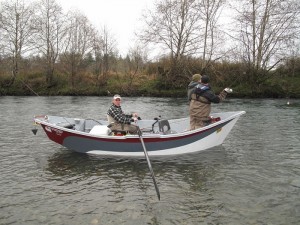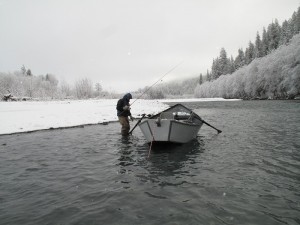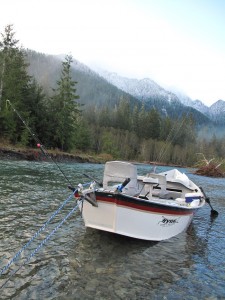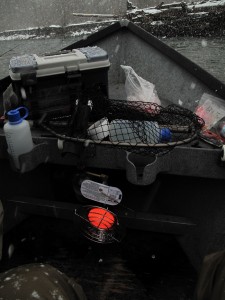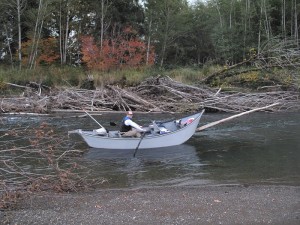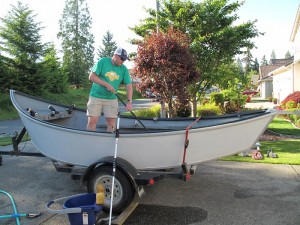The Versatile Drift Boat Leave a reply
by Jason Brooks
If you ask me what is the most versatile watercraft to pursuit salmon and steelhead I would have to say it’s the drift boat. With its distinctive up curved ends and flat bottom designed and built to float in skinny northwest rivers it also handles bigger waters such as mainstream rivers, estuaries, and bays. Add in the fact that they are extremely economical with very little maintenance and it’s no wonder that their popularity is making a huge comeback.
It all started on the McKenzie River in Oregon, or at least that is the legend of where the drift boat originated. In fact some people still call them McKenzie drifters, or just plain McKenzie boats. First made of wood the early boats proved to be useful for getting down a river. If you hit a rock or damaged the hull you could patch it with some basic hand tools, back when most people actually still used hand tools and made a lot of their own boats. Nowadays with modern fabrications the wooden boat is all but gone, though you can still find them for sale on Craigslist. They are more for nostalgia as wood boats are a bit heavier and tend to not row as easy. So the modern argument for this old design is fiberglass or metal when it comes to hull materials.
I see it posted several times on internet forums, usually around the time the Outdoor Trade Shows or Boat Shows start up. Someone will get the itch to buy a drift boat and ask fellow fishers what they should get, a “glass” or metal boat. I sit back and read the replies from the internet experts until I can’t take it anymore and chime in my opinion. I start by saying that if the person who is thinking about buying a drift boat has never rowed one to first take a guided trip. It is well worth the money to see if you really want to invest in one of these boats. This usually leads to my next bit of advice, take it or leave it, but I think anyone who wants to get into their first drift boat should buy a used one. Now, before the advertisers of this site get too mad, I am only advocating this for the first time buyer, as soon enough the person will want to upgrade and look to have a boat manufacturer make a custom boat for them.
Here is my reasons why you should consider used for your first drift boat and why a guided trip is a must prior to the purchase. If you have patience and look at sale sites for any length of time you will find those ads by people who offer up a practically new boat for half the cost. Ones where the person decided to get a drift boat and spent the money only to float a river and find out that rowing can be harder than it looks. Either it scared them to have no control over the fact you have to go down the river, or they were too sore to care to row ever again. Also, drift boats hold up pretty well, even boats that have some road rash or a few dents float just fine. You can find really good deals on boats that are 10 years old or older, and really the design of the boat hasn’t changed in 50 years so age isn’t much of a factor. The main difference between a new boat and a used one are options. When buying used you are stuck with what the previous owner purchased. This can work in your favor as a bare bones boat is lighter and easier to row than one that has lots of bells and whistles.
New boats are nice and once you own a drift boat and become proficient at rowing one you will get the itch to order your own boat. This is mostly because each person is slightly different when it comes to fishing styles. I like to drift fish and float eggs under a bobber, but another buddy of mine likes pulling plugs and throwing hardware. So for me multiple rod holders, bait trays, motor mount, and other accessories are a must. For the guy who likes to pull plugs you want it set up with pole holders, a heater for those cold days where the front passengers are just sitting idle watching the rod tips thump.
This brings us back to the argument of “glass” versus metal. I really don’t have a preference but I do own a metal boat and one of my buddies owns a fiberglass boat. Both are great boats and ironically my boat actually floats higher in the water than his does. Most think that the material matters, and to some degree it does, but so does design. His is a 16 foot by 48 inch bottom. Mine is a 16 foot by 54 inch bottom. That extra width at the bottom of the boat is what allows mine to float or draft higher and slip through in shallower waters and makes it react to rowing a bit quicker. His is “warmer” as my metal boat becomes an ice bucket during those early spring steelhead trips.
Okay, if you just read all of this and are scratching your head at what the heck I am talking about; “how it rows, reacts faster, floats higher”. Here is what drift boaters are talking about. The boat is designed to float with very little displacement, or otherwise known to float high in the water by its flat bottom design. With the stern and bow raised is allows the water to push the boat up as the water flows underneath. As you row backwards you pull the boat up and away from where the bow is pointed. If the boat is heavy or narrow and sits lower in the water there is more drag or resistance and you need to row harder, either faster or by digging you oars deeper into the water. Fiberglass boats are slick and have less coefficient of friction on the bottom because of the materials they are made from. Fiberglass that is coated with a gel coat has very little resistance in the water, where metal boats have tiny grooves or pores which tend to cause more friction in the water. To overcome this metal boat owners put a coating on the bottom of the boat and with new Kevlar materials these coatings can stand up to a few years of use. But they must be up kept, one of the downfalls of a metal boat. Fiberglass boats do wear out and can have soft spots or leaks from hitting rocks or gouges from sliding over gravel bars.
All drift boats have some basic maintenance requirements, but not many. This is another bonus for owning one these boats. If you put a motor on one you must also license it. Keep the motor off and stay away from Federal or navigable waters defined by the Coast Guard and there is no need to license it in Washington (check your local laws). With the motor you can easily fish close to shore in bays and estuaries and also motor up the deep holes and slot in rivers to float them again. But one of my favorite reasons to own this versatile boat is that it is quiet and allows you to really pay attention to fishing and relax while floating down a river.
Jason Brooks
Northwest Outdoor Writer


